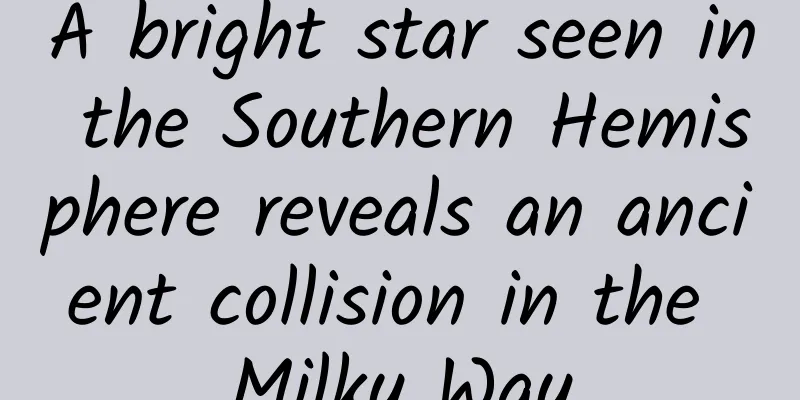A bright star seen in the Southern Hemisphere reveals an ancient collision in the Milky Way

|
A bright star in the cluster, visible from the Southern Hemisphere, has revealed new insights into an ancient collision between our Milky Way and another, smaller dwarf galaxy, Gaia-Enceladus, early in our galaxy's history. An international team of scientists, led by the University of Birmingham, used a novel approach to apply the signature of an ancient bright star, called ν Indi, to the Milky Way's history. Stars carry a 'fossil record' of their history, and therefore of the environment in which they formed. The team used satellite and ground-based telescope data to unlock this information about ν Indi, and their results are published in the journal Nature Astronomy. The star's natural oscillations (asteroseismology) were detected and aged in data collected by NASA's Transiting Exoplanet Survey Satellite (TESS) TESS. Launched in 2018, TESS is surveying stars across a large part of the sky to search for planets orbiting around them and to study the stars themselves. When combined with data from the European Space Agency's (ESA) Gaia mission, this detective story revealed the birth of this ancient star early in the life of the Milky Way. But the collision changed its motion through our own galaxy, Bill Chaplin, Professor of Astrophysics at the University of Birmingham and lead author of the study, said: "Since ν Indi's motion was affected by the Gaia-Enceladus collision, the collision must have occurred after star formation. That's why we were able to use the age determined by asteroseismology to place new constraints on the timing of the Gaia-Enceladus event." Co-author Dr Ted MacLeith, also from Birmingham, said: "Because we see so many stars from Gaia-Enceladus, we think it must have had a big impact on the evolution of our own galaxy." Understanding this is a very hot topic in astronomy right now, and this study is an important step towards understanding the timing of this collision. This study demonstrates the potential of TESS for asteroseismology, and what is possible when one has such a wide range of cutting-edge data about a bright star. This study clearly shows the strong potential of the TESS mission to gather rich new insights about the stars that are our closest neighbours in the Milky Way. This research was funded by the Science and Technology Facilities Council and the European Research Council through the Astronomical Timing programme. Over the course of its history, the Milky Way has engulfed multiple smaller satellite galaxies, and while these accreted populations of stars can be identified as kinematically distinct structures within the Milky Way, it is generally difficult to accurately determine the age of any one merger. New results show that a large population of stars was accumulated through the collision of the Gaia-Enceladus 1 dwarf galaxy, resulting in a significant contamination of the chemical and dynamical properties of the Milky Way. This study identifies the very bright star ν Indi as an indicator of the age of the early "in situ population" of the Milky Way. The study combined asteroseismology, spectroscopy, astrometry and kinematic observations to show that this metal-poor, alpha-rich star is a local member of the halo, and its age is measured to be \(11.0\pm 0.7\)(Stat)\(\pm 0.8\)(Sys) billion years. This star has features consistent with collisional motion heating, and its age means that the merger may have started as early as 11.6 billion years ago and 13.2 billion years ago, with 68% and 95% confidence, respectively. Calculations based on the hierarchical universe model slightly reduce the above restrictions. Bokeyuan|www.bokeyuan.net Bo Ke Yuan | Research/From: University of Birmingham Reference journal Nature Astronomy DOI: 10.1038/s41550-019-0975-9 BoKeYuan|Science, technology, research, popular science |
<<: 14 famous brands of oyster sauce, you will know which one to choose after reading this!
>>: The April celestial "theater" is also beginning to "warm up" with the spring in the air
Recommend
After staying up late, don't do these two things! Seriously, you may die!
Have you ever had this magical experience: due to...
Getting started with operations: How to build a data analysis knowledge system from 0 to 1
Data analysis is ubiquitous in operational work. ...
iFlytek's automotive business grew by 30%, with total revenue of 3.21 billion in the first half of the year
On August 14, iFLYTEK released its 2018 semi-annu...
Learn ASO from scratch: 10 minutes to help you fully master ASO!
According to the latest statistics, China has bec...
A mobile phone reflects the great power dream of "Made in India" and the globalization of "Chinese factories"
If Indians don’t work harder, Mumbai will be surp...
Traditional car companies enter the travel field? Toyota and Didi set up a joint venture company Fengju Travel
Recently, Toyota and Didi's joint venture Fen...
Core skills of Double Eleven marketing activities!
Since 2014, November 11th of every year has becom...
Here are 3 suggestions for your “big life events” in the coming year…
In the new year, everyone should have a new look....
The Double 11 marketing of this e-commerce company is a little different from that of Tmall and JD.com
Since the rapid development of the Internet indus...
Summary of practical experience in 3 steps of community operation!
A while ago, a friend of mine just started a busi...
How to plan a screen-sweeping event, 4 tips!
How to plan a screen-sweeping event? Just read th...
Woolen sweaters shrink after washing. If a sheep is caught in the rain, will it be strangled to death by the wool?
I believe everyone has had this experience: a goo...
Adding this to water can help fight cancer, resist oxidation, and enhance immunity? The truth is...
It is hard to imagine that such tempting keywords...
Mobile game developers should pay attention to these 6 trends in 2016
We are already halfway through 2016, but that doe...
Learn these 6 ways to play, and your Douyin account can also bring goods
As Douyin’s ability to sell goods continues to im...









